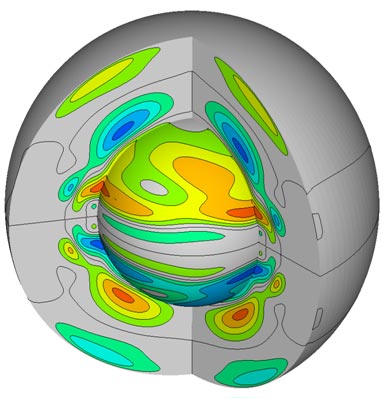 |
 |
||||||||||||||||||||||||||||||||||||||
|
Studying of the flows in rotating spherical layers Study of the stability of liquid and gas shear flows in rotating spherical layers began in the 1970-th. The flow in the spherical layers is of astrophysical and geophysical interest and is related to the problems of planetary and stellar atmospheres, oceans, robes. The flow of the viscous fluid in the spherical layer, resulting from rotation of the layer boundaries, is simplified model of real processes, but it allows to obtain some their general characteristics. The resulting flow is called the spherical Couette flow by analogy with flat and cylindrical Couette flows.
An experimental setup was created, which consists of two coaxial optically-transparent spheres, has a wide range of angular velocities of the spheres. Inner sphere is replaceable to study spherical flows of various thickness. Over the 1975 to 1995 period Yu.N. Belyaev, I.M. Yarovaya and their co-authors conducted a detailed series of experimental studies of the spherical Couette flow. Nonuniqueness of scenarios of the transition to chaos, depending on the flow history, was revealed in recent studies. It was shown that formed near the transition boundary, chaotic regimes can be characterized by strange attractors of low dimension. These results obtained international recognition and are honored with academician Petrov prize.
Calculated secondary flow structure in the spherical layer after the first bifurcation (contour of vorticity radial component). Counter rotation of spherical boundaries, Re1 = 340, Re2 = -900 (the first part of the movie).
The structure of quasi-periodical flow with three independent frequencies in the velocity spectrum at Re1 = 378, Re2 = -900 (the second part of the movie). Later, the digital control system of the rotation of the spheres was created in collaboration with the laboratory mechanics and electronics of the Institute of Mechanics, Lomonosov Moscow State University. Due to this modernisation, new experimental results were obtained. The possibility of transition to chaos through spatial-temporal intermittency was shown, the influence to the laminar-turbulent transition of the method of boundary conditions changing was studied. The possibilities of formation of turbulent flows with different spatial structures and spectra of the turbulent velocity fluctuations were developed. Now lead scientists, D. Zhilenko (Ph.D.) and O. Krivonosova (Ph.D.) investigate transition routes of spherical flows in our laboratory. |
||||||||||||||||||||||||||||||||||||||
| Last update: june of 2025 | |||||||||||||||||||||||||||||||||||||||